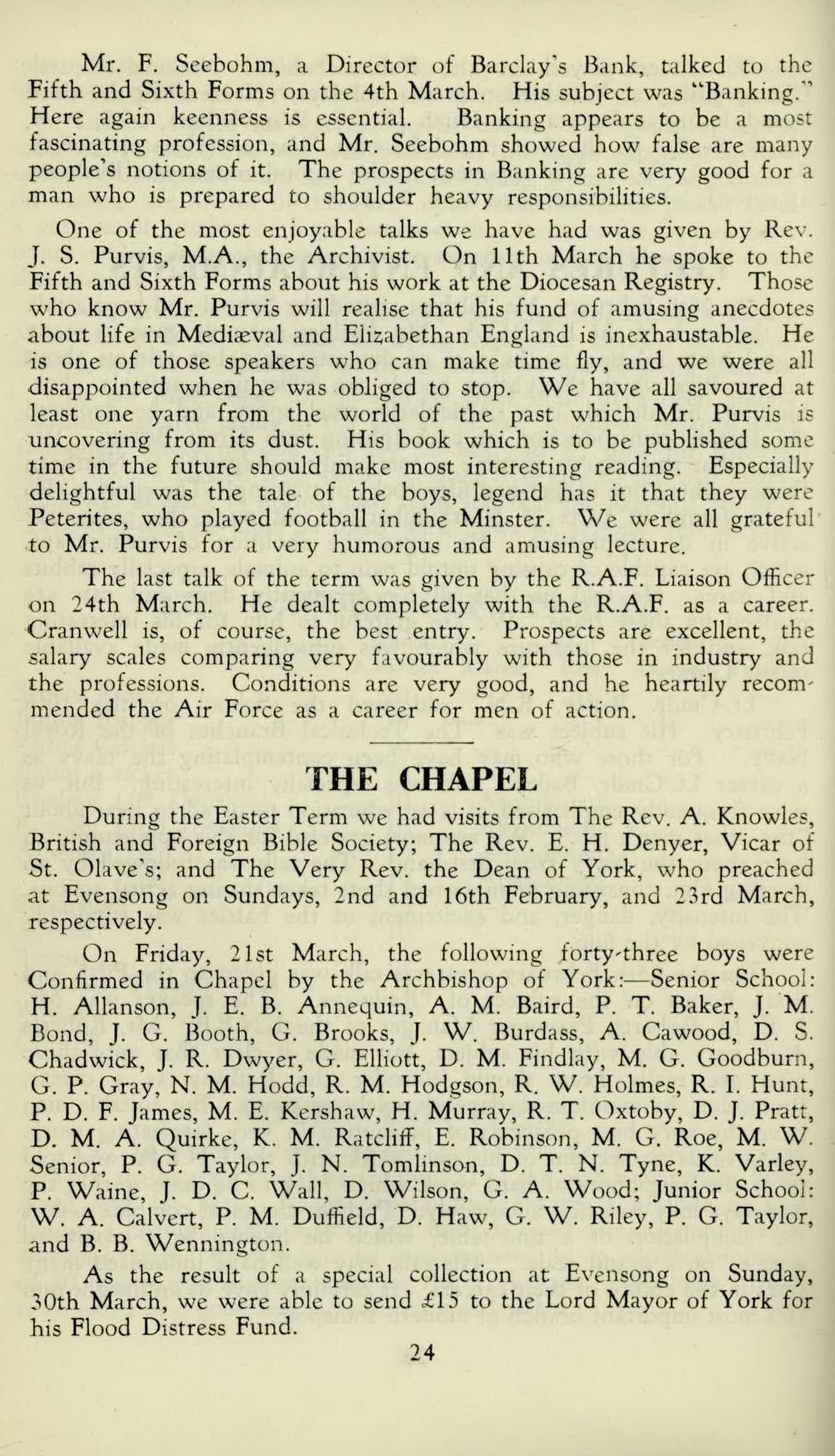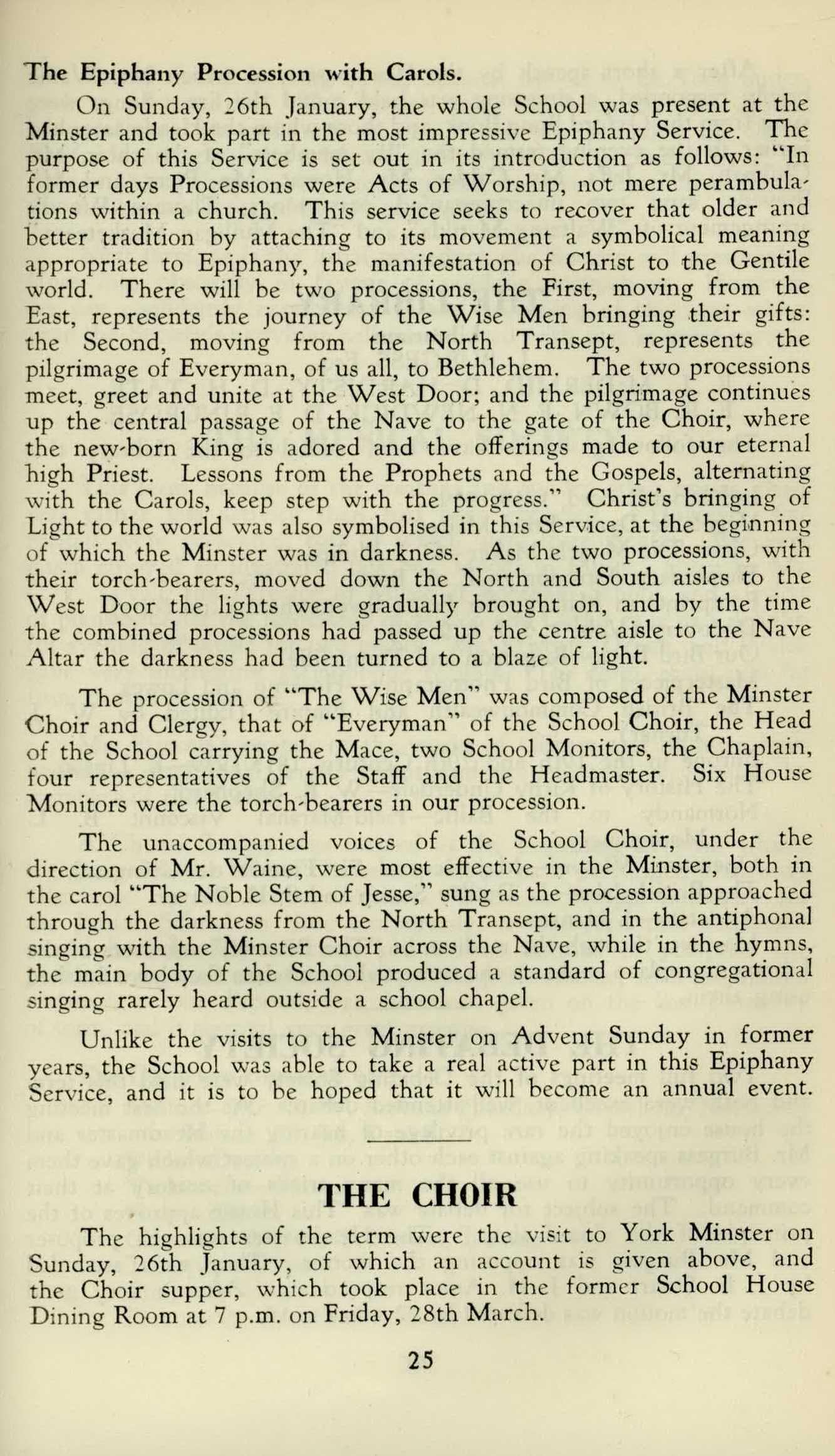
4 minute read
The Chapel
from May 1947
by StPetersYork
Mr. F. Seebohm, a Director of Barclay's Bank, talked to the Fifth and Sixth Forms on the 4th March. His subject was "Banking." Here again keenness is essential. Banking appears to be a most fascinating profession, and Mr. Seebohm showed how false are many people's notions of it. The prospects in Banking are very good for a man who is prepared to shoulder heavy responsibilities.
One of the most enjoyable talks we have had was given by Rev. J. S. Purvis, M.A., the Archivist. On 11th March he spoke to the Fifth and Sixth Forms about his work at the Diocesan Registry. Those who know Mr. Purvis will realise that his fund of amusing anecdotes about life in Mediaeval and Elizabethan England is inexhaustable. He is one of those speakers who can make time fly, and we were all disappointed when he was obliged to stop. We have all savoured at least one yarn from the world of the past which Mr. Purvis is uncovering from its dust. His book which is to be published some time in the future should make most interesting reading. Especially delightful was the tale- of the boys, legend has it that they were Peterites, who played football in the Minster. We were all grateful' -to Mr. Purvis for a very humorous and amusing lecture.
The last talk of the term was given by the R.A.F. Liaison Officer on 24th March. He dealt completely with the R.A.F. as a career. •ranwell is, of course, the best entry. Prospects are excellent, the salary scales comparing very favourably with those in industry and the professions. Conditions are very good, and he heartily recommended the Air Force as a career for men of action.
During the Easter Term we had visits from The Rev. A. Knowles, British and Foreign Bible Society; The Rev. E. H. Denyer, Vicar of St. Olave's; and The Very Rev. the Dean of York, who preached at Evensong on Sundays, 2nd and 16th February, and 23rd March, respectively.
On Friday, 21st March, the following forty-three boys were Confirmed in Chapel by the Archbishop of York:—Senior School: H. Allanson, J. E. B. Annequin, A. M. Baird, P. T. Baker, J. M. Bond, J. G. Booth, G. Brooks, J. W. Burdass, A. Cawood, D. S. Chadwick, J. R. Dwyer, G. Elliott, D. M. Findlay, M. G. Goodburn, G. P. Gray, N. M. Hodd, R. M. Hodgson, R. W. Holmes, R. I. Hunt, P. D. F. James, M. E. Kershaw, H. Murray, R. T. Oxtoby, D. J. Pratt, D. M. A. Quirke, K. M. Ratcliff, E. Robinson, M. G. Roe, M. W. Senior, P. G. Taylor, J. N. Tomlinson, D. T. N. Tyne, K. Varley, P. Waine, J. D. C. Wall, D. Wilson, G. A. Wood; Junior School: W. A. Calvert, P. M. Duffield, D. Haw, G. W. Riley, P. G. Taylor, and B. B. Wennington.
As the result of a special collection at Evensong on Sunday, 30th March, we were able to send X15 to the Lord Mayor of York for his Flood Distress Fund.
The Epiphany Procession with Carols.
On Sunday, 26th January, the whole School was present at the Minster and took part in the most impressive Epiphany Service. The purpose of this Service is set out in its introduction as follows: "In former days Processions were Acts of Worship, not mere perambulations within a church. This service seeks to recover that older and better tradition by attaching to its movement a symbolical meaning appropriate to Epiphany, the manifestation of Christ to the Gentile world. There will be two processions, the First, moving from the East, represents the journey of the Wise Men bringing their gifts: the Second, moving from the North Transept, represents the pilgrimage of Everyman, of us all, to Bethlehem. The two processions meet, greet and unite at the West Door; and the pilgrimage continues up the central passage of the Nave to the gate of the Choir, where the new-born King is adored and the offerings made to our eternal high Priest. Lessons from the Prophets and the Gospels, alternating with the Carols, keep step with the progress." Christ's bringing of Light to the world was also symbolised in this Service, at the beginning of which the Minster was in darkness. As the two processions, with their torch-bearers, moved down the North and South aisles to the West Door the lights were gradually brought on, and by the time the combined processions had passed up the centre aisle to the Nave Altar the darkness had been turned to a blaze of light.
The procession of "The Wise Men" was composed of the Minster Choir and Clergy, that of "Everyman" of the School Choir, the Head of the School carrying the Mace, two School Monitors, the Chaplain, four representatives of the Staff and the Headmaster. Six House Monitors were the torch-bearers in our procession.
The unaccompanied voices of the School Choir, under the direction of Mr. Waine, were most effective in the Minster, both in the carol "The Noble Stem of Jesse," sung as the procession approached through the darkness from the North Transept, and in the antiphonal singing with the Minster Choir across the Nave, while in the hymns, the main body of the School produced a standard of congregational singing rarely heard outside a school chapel.
Unlike the visits to the Minster on Advent Sunday in former years, the School was able to take a real active part in this Epiphany Service, and it is to be hoped that it will become an annual event.

THE CHOIR
The highlights of the term were the visit to York Minster on Sunday, 26th January, of which an account is given above, and the Choir supper, which took place in the former School House Dining Room at 7 p.m. on Friday, 28th March.










